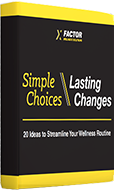The 7th Inning Stretch - An Introduction to The Top Static Stretches Series
The 7th Inning Stretch is a common tradition at American baseball games where fans get the chance to get up and stretch out their arms and legs in the 7th inning before sitting down again to watch the rest of the game. Maybe fans were on to something when they began participating in this tradition many, many years ago.After long periods of sitting and inactivity, the muscles shorten causing tightness that can lead to pain and discomfort. Instead of ignoring the pain and tightness, it's important to give yourself a "7th Inning Stretch" in your day to stretch out those tight muscles and avoid possible muscle imbalances.

So what is flexibility anyway? Flexibility is defined as the normal extensibility of all soft tissues that allow the full range of motion of a joint (NASM, 2008). The use of flexibility training may decrease the chance of muscle imbalances, joint dysfunctions, and overuse injuries. Stretching isn't only important before and after exercise, it is also important to perform stretches daily to keep muscles loose and functioning. Stretching is more important than ever in today's society due to decreases in physical activity and prolonged sitting periods in the American population.
There are many benefits of stretching. These benefits include but are not limited to: improved range of motion, increased power, reduced post exercise muscle soreness and reduced fatigue. Some added benefits to stretching include: improved posture, improved coordination, promotes circulation, increases energy and improves relaxation and stress relief (Walker, 2007).

There are 3 types of Flexibility
- Corrective flexibility focuses on correcting muscle imbalances and altered joint motion. This form of flexibility utilizes static stretching and self-myofascial release.
- Active flexibility improves the extensibility of soft tissue and increases neuromuscular efficiency by using reciprocal inhibition. Active flexibility utilizes self-myofascial release and active-isolated stretching. Finally, functional flexibility is integrated, multiplanar soft tissue extensibility, with optimum neuromuscular control, through a full range of motion.
- Functional flexibility uses self-myofascial release and dynamic stretching (NASM, 2008). We will be addressing mainly corrective flexibility, because it is a great place for someone to start if they aren't used to performing flexibility exercises.
Here are some tips that are important to keep in mind before beginning a daily stretching routine:
• Warm-up prior to stretching. If preparing for exercise, do some light physical activity for about 10 minutes. You should work up a light sweat. If stretching in the middle of the day, march or jog in place for about 5 minutes to get the blood flowing and loosen up a little bit, then proceed to stretching. Stretching a cold muscle is like stretching a cold rubber band; warming up will increase muscular pliability and improve the effectiveness of your stretches.
• Stretch all major muscle groups and their opposing muscle groups. All muscles are important in physical activity. Just because a certain muscle group is used in a particular activity does not mean that the rest should be ignored. Stretching all major muscle groups is important in order to avoid imbalances. • Stretch gently and slowly. This will make stretching more pleasurable and beneficial since hard jerky movements can cause injuries and further discomfort.
• Stretch only to the point of tension. "When the muscles are stretched to the point of pain, the body employs a defense mechanism called the stretch reflex. This is the body's safety measure to prevent serious damage occurring to the muscles, tendons and joints," (Walker, 2007). Therefore, if the muscle is stretched to the point of pain, the protective mechanism prevents the stretch from occurring. In order to avoid the stretch reflex from happening, avoid pain and only stretch to the point of tension.
• Breathe slowly and easily while stretching. Holding your breath while stretching decreases oxygen delivery to the muscles, causing tension in the muscles making it difficult to get a good stretch. To evade this, breathe deeply and slowly while stretching to promote blood flow and delivery of oxygen to the muscles.
• Stretch with proper form to avoid causing imbalances in the muscles that can lead to injury. A major muscle group can be made up of a number of different muscles and altering the posture of a stretch can put more stress on one particular muscle, therefore creating an imbalance (Walker, 2007).
• Hold the stretch for 30-60 seconds when using static stretching. This will give the muscles ample time to completely relax and reach full extensibility.
Following all of these guidelines will not only ensure that the stretches are performed correctly, but will also help you on your way to reaping the many benefits of a regular stretching program. Take some time out of your busy day to participate in a "7th Inning Stretch". This simple addition to your daily routine is a great opportunity to break up your day, loosen up those muscles, and help you to feel re-energized and ready to tackle the rest of the day.
We have taken the time to pull together our Top Static Stretches and put them in a series to help you remember which muscles to focus on and how to properly stretch them. Start from the bottom and work your way up. Adding flexibility training to your routine will help you feel great and stay injury free.
Top Static Stretches Series
- Calves
- Achilles and Soleus
- Quadraceps
- Adductors
- Abductors
- Hip Flexors
- Low Back
- Latissimus Dorsi and Triceps
- Abdominals
- Upper Back
- Hamstrings
- Pectorals and Deltoids
- Neck
References:
Lucett., & Clark, C. -. (2008). Flexibility Training Concepts. NASM Essentials of Personal Fitness Training (pp. 139-171).
Philadelphia: Wolkers Kluwer/Lippincott Williams And Wilkins. Walker, Brad. Anatomy of Stretching. California: North Atlantic Books, 2007.
Leave a Comment
Comments (11)
Latest X Factor post
Is your body saying you're old, but your mind isn't willing to give in? If you've ever felt discouraged by the challenges of health & fitness after 40, we've got a few tips, and a toolbox to help.
View BlogReceive "20 Ideas to Streamline Your Wellness Routine."
 Sign up for our "Weekly Wellness Tip" and get your free report "Simple Choices, Lasting Changes: 20 Ideas to Streamline Your Wellness Routine." The report gives you simple, smart ideas that can help you feel better and be more productive during your work day.
Sign up for our "Weekly Wellness Tip" and get your free report "Simple Choices, Lasting Changes: 20 Ideas to Streamline Your Wellness Routine." The report gives you simple, smart ideas that can help you feel better and be more productive during your work day.

Filip:
Aug 29, 2010 at 10:38 AM
Looks really good½ can not wait to utilize it.
Matt Trudo:
Aug 31, 2010 at 04:53 PM
Thank you. There is room for many workout techniques and styles, as long as they are safe and based on solid research. I appreciate the positive reinforcement.
Miko:
Sep 09, 2010 at 05:36 AM
...and, just like exercise, the more you stretch, the more it feels so good to do! Everyone, write yourselves a note with this word on it and post them around the home and office: "stretch" Excellent article, Matt.
Matt Trudo:
Sep 10, 2010 at 09:55 AM
Well thank you Miko. It's nice to hear from you. I'm glad you are still out there spreading the good work. Stop by any time, we have more coming.
Melbourne Personal Trainer:
Aug 13, 2010 at 05:10 AM
good info, easy to read.. thanks for sharing!
Matt Trudo:
Aug 18, 2010 at 12:42 PM
thanks, we try to be informative. We appreciate the support.
Keniston:
Aug 13, 2010 at 07:34 PM
Such a well written post.. Thnkx for sharing this post!
Patti Henriksen:
Aug 26, 2010 at 05:43 AM
Hey amazing web log, I saw your site when I was research on possibly how to develop my web log. I was simply wondering which spam software program you employ for comments because I get a great deal on my blog.
Matt Trudo:
Aug 31, 2010 at 05:03 PM
Currently the span software is me, and I have 53 comments (mostly spam) that I am filtering through. I have got to find an easier way. It is nice to respond to a comment that looks like it actually came from a real person. Thanks you.
Ashley:
Sep 08, 2010 at 01:26 PM
hey, nice blog...really like it and added to bookmarks. keep up with good work
Matt Trudo:
Sep 08, 2010 at 01:39 PM
Well thank you Ashley. I really appreciate it. We put a lot of work into our blogs and love it when people appreciate the effort. Let up know if there is anything more we can assist with.